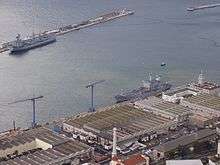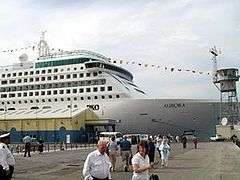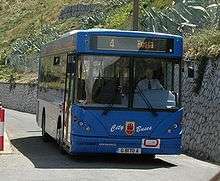Transport in Gibraltar
Gibraltar has a limited public transport system, due to the compact size of the territory.
Road
Private transport



Gibraltar has 49.9 kilometres (31.0 mi) of highways, all of which are paved. It has one of the highest levels of per capita car ownership in the world, with as many motor vehicles as people. Unlike the United Kingdom, traffic in Gibraltar drives on the right, as it shares a land border with Spain. Traffic formerly drove on the left; the change to driving on the right was made at 5.00 a.m. on 16 June 1929.[1]
Older roads in Gibraltar, primarily in the city centre, are fairly narrow with a typical speed limit of 50 km/h (31 mph). Gibraltar has ten fuelling stations, and fuel prices are lower than in neighbouring Spain. Some people from Spain even enter Gibraltar for the sole purpose of filling their cars' fuel tanks.
Gibraltar's international vehicle registration is GBZ, and Gibraltar car number plates consist of the letter 'G' followed by up to five digits (1-99999) or four digits (1000-9999) and a single letter. These are as standard, the same shape, type face and colours as those in the UK, however non-standard number plates have been permitted. The Chief Minister's official car has the registration number G1, while the Governor's car, following tradition, has a crown, in place of a number.
The two highways in Spain leading in the vicinity are the A-383 which ends in La Linea, and the CA-34, which leads to the border.
Public transport

There are a total of 8 different bus routes in Gibraltar. There are two companies who provide stage-carriage bus services in Gibraltar: Gibraltar Bus Company Limited and Calypso Transport Limited. The Gibraltar Bus Company is 100% owned by the Government of Gibraltar and operates all but one of the services here. Calypso Transport operates the other, linking the city centre with the airport and the Frontier (border with Spain).
The Gibraltar Bus Company operates Services 1, 2, 3, 4, 7, 8 & 9 with its distinct fleet of modern, blue buses. The company has a total of 21 vehicles in its bus fleet, 18 of which are the Dennis Dart low-floor midibus with Caetano Nimbus bodies and featuring 28 seats and 3 Mercedes-Benz Sprinter minibuses with Unvi bodies and catering for 15 seated passengers. The Darts entered service the day the company was officially formed, Saturday 10 April 2004, when it took over the operation of private company Rock City Services Limited, who had been unwilling to invest in its fleet. The trio of Sprinters entered service during November 2010 and operate Service 1 to the Moorish Castle Estate in the Upper Town area of the city. This route is well worth travelling in order to see how narrow and winding the roads are in this part of town. The latest timetable is dated 1 September 2012.
Calypso Transport Ltd operates Service 5 between the Frontier (the land border with Spain), the airport and the city centre and tickets between this route and those operated by the Gibraltar Bus Company are not inter-changeable. An adult single fare on either operators' services currently costs £1.00 and an all-day Hoppa ticket costs £1.50. A year-long trial period where free travel was permitted aboard the buses of the Gibraltar Bus Company ended in May 2012 and only qualifying residents, commuters and military personnel now qualify for free travel in the province.
Bus Fares - Both Operators' Services
| Single | All Day Pass. | |
|---|---|---|
| Adult | £1.50 | £2.25 |
| Pensioner | £0.75 | £1.20 |
| Child | £1.20 | £1.80 |
Calypso Transport Ltd uses a fleet of red double-decker buses.

Route 5 buses run every 10 minutes Frontier/Airport terminus to the city centre, this is a shuttle between Reclamation Road (British Steps) near John Macintosh Square and the Frontier/Airport terminus via the Market Place bus station Grand Casemates Square.
Gibraltar Bus Company increased the bus fares for all routes in Gibraltar in May 2013.
Taxis
Taxicabs are available from a number of taxi ranks around the Rock. Many taxis cater specifically for tours of the Upper Rock Nature Reserve and these can be picked up from the frontier or the city centre, however, taxi drivers are also obliged to take standard fares as well as tours.
Rail
Historical
There are no extant railways in Gibraltar. There was formerly an extensive railway within the Gibraltar Dockyard, and neighbouring works and storage facilities. It included tunnels, one of which went through the Rock of Gibraltar, and is still in use today as a road tunnel. At the turn of the 19th and 20th centuries there was also a temporary industrial railway in Gibraltar. At the period when both railways were operational, it was possible to travel right round the entire coastline of Gibraltar by train.[2] The dockyard railway had a roster of 17 locomotives, distinguished by numbers, but four of which also carried names: Gibraltar, Catalan, Rosia, and Calpe.
Access to the rail system in Spain
Whilst railway track extends to the outskirts of La Linea from the aborted San Roque-La Línea railway line expansion project in the 1970s,[3][4] the nearest actual railway station (in Spain) is "San Roque - La Línea" station on the ADIF line from Algeciras to Bobadilla Junction via Ronda.
Until 1969 a ferry from Gibraltar provided convenient access to Algeciras station, which along with the railway line to Ronda was built by a British company known as the Algeciras Gibraltar Railway Company.
Access to the rail system in Morocco
Ferries by FRS running twice a week from Gibraltar to Tanger-Med port provide access to the Moroccan railway system.[5][6]
Sea


Being a peninsula, the sea has long been vital to Gibraltar's transport links. The Royal Navy Dockyard was formerly Gibraltar's major employer. There is still a harbour on the west side of the territory. The Gibraltar-registered merchant marine consists of 26 ships of 1000 tonnes and above. There is an irregular direct regular fast ferry service to Tanger-Med port, Morocco but many passengers now travel from Algeciras or Tarifa due to a more regular service being present at those ports.
The ferry between Gibraltar and Algeciras, which existed until 1969, when communications with Spain were severed by the Spanish dictator Francisco Franco, was reopened on 16 December 2009, served by the Spanish company Transcoma,[7] which used a catamaran, Punta Europa Segundo in memory of the original ferry that served the cross-Bay route in the 1960s. The maritime operations of Transcoma were taken over by Grupo Medex on 10 November 2010, which announced a higher-capacity new ship for 2011.[8]
Various cruise liners visit the Port of Gibraltar throughout the year, and dock at the Gibraltar Cruise Terminal on the Western Arm of the North Mole. This provides the means of transport for a significant proportion of day-tripper tourists arriving in the territory.
Air

Gibraltar Airport is the territory's only airport. It is situated very close to the border with Spain. The road to Spain crosses the runway, requiring the road to be closed each time an aircraft lands or takes off. Scheduled civilian passenger flights are operated by EasyJet, British Airways and Monarch Airlines.
Following an agreement signed in Córdoba between the Governments of the United Kingdom, Spain and Gibraltar in September 2006, the use of Gibraltar Airport by both Gibraltarian and Spanish services was agreed. Gibraltar Airport will be adapted to have an entrance from Spain (as well as Gibraltar), in a similar manner to Basel and Geneva airports (which are also adjacent to borders).
Iberia commenced direct flights between Madrid and Gibraltar on 16 December 2006 with GB Airways following on 1 May 2007. However, GB Airways discontinued their Madrid service on 30 September 2007 and Iberia subsequently considered using smaller aircraft, possibly from its Air Nostrum regional partner — indicating that neither operator may have been able to fill their planes with passengers. Iberia eventually withdrew its service in September 2008. In 2009 Ándalus Líneas Aéreas started flights between Gibraltar and Madrid. However, on 13 August 2010, the airline ceased operations because the Spanish aviation authorities withdrew their licence.
Following the takeover by EasyJet, GB Airways dropped its direct Gibraltar–Heathrow service on 28 October 2006[9] despite apparently remaining popular. The reason cited by GB Airways was the "convenience of" concentrating all its London services onto a single hub at Gatwick. Later, a sale of several of GB Airways' Heathrow slots is believed to have netted GB Airways with up to £80m.[10] In late 2007 GB Airways was bought by EasyJet (and thus ceased to be a British Airways franchise partner); all flights were rebranded as EasyJet in 2008.
Flights are available from Gibraltar to London Heathrow, London Gatwick, London Luton, Liverpool, Birmingham and Manchester airports. During 2012 bmibaby offered a service to East Midlands airport, but the airline ceased operations in September 2012.
Cable car

A cable car runs from just south of the city centre to the Ape's Den and the Top of the Rock, which despite its name is actually the second highest peak of the Rock.
Dispute with Spain
The road crossing into Spain was closed by the Spanish authorities in 1969 and only reopened for pedestrians in 1982 and for vehicles in 1985.
A ferry operated between Algeciras and Gibraltar until 1969. For a few months in 2004 Spain banned cruise ships which had visited Gibraltar from going to Spanish ports on the same journey. In 2003, the land frontier was closed for a day by Spain on the grounds that a visiting cruise liner, the MV Aurora, was affected by contagious food poisoning.[11] No cases in Gibraltar were reported.
The airport is built on the isthmus which the Spanish Government claim not to have been ceded in the Treaty of Utrecht, thus the integration of Gibraltar Airport in the Single European Sky system has been blocked by Spain. The 1987 agreement for joint control of the airport with Spain was rejected by the then Government of Gibraltar. All successive Governments of Gibraltar have rejected it, although welcoming joint use of the airport (which being next to the border could operate in a similar manner to Geneva Airport or Basel Airport). Following the Cordoba Agreement (between the UK, Spain and Gibraltar) in 2006, the joint use of the airport was finally agreed.
The road crossing from Gibraltar into Spain can often be subject to long delays. A loop road is located next to the border to hold cars waiting in the queue to cross into Spain. Motorists (and sometimes pedestrians) crossing the border are randomly subjected to long delays and searches by the Spanish authorities.
References
- ↑ Kincaid, Peter (1986). The Rule of the Road: An International Guide to History and Practice. Greenwood Press. p. 109. ISBN 0-313-25249-1.
- ↑ Friends of Gibraltar Heritage Society, December 2003, pp 7-8, ptovide full details.
- ↑ http://www.europasur.es/article/lalinea/835676/la/linea/lleva/mas/ochenta/anos/esperando/pase/primer/tren.html
- ↑ https://maps.google.com/maps?q=36.175256,-5.359137
- ↑ http://goafrica.about.com/od/morocco/a/moroctraveltips_2.htm
- ↑ http://www.seat61.com/Morocco.htm
- ↑ New ferry 'repairs 40 year gap' says Spanish Diplomat, Gibraltar Chronicle, December 17, 2009
- ↑ Gib Ferry Company Taken Over, Gibraltar Chronicle, November 10, 2010
- ↑ Gibraltar News Online, GB Airways drop Gib-Heathrow route this Winter
- ↑ Gibraltar News, GB Airways sells Heathrow slots for £80 million
- ↑ MV Aurora - Fury over Gibraltar border closure
| Wikimedia Commons has media related to Transport in Gibraltar. |
